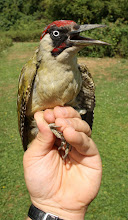Yesterday, Saturday 16th August, I made a visit to Sandy Smith Nature Reserve - same as I do most weekends. Starting at the crack of dawn, I set up my nets and I was well rewarded for my efforts.
The weather conditions and time of year, all play their part in the presence (or absence) and abundance of birds and the species I might catch. This year Blue Tit juveniles have been rather thin on the ground, as have Common Whitethroats despite what appears to have been a good year weather wise for breeding.
Yesterday, the ringing results showed 2 things - no Common Whitethroats (I should still be catching them) and a marked increase in the no. of Blue Tits ringed. This increase is probably as a result of birds from 'further afield' arriving on site.
In the end, I caught 111 birds of 15 species. This being the joint highest ringing total for a single day at this site.
Of course, I took some photographs...
Above: A juvenile Jay (3rd youngster ringed this year)
Having caught 1 Jay (2013) previous to this year, it has been a pleasant surprise to catch 5 so far this year (3 adults, 2 juvs). My main ringing area is being left to mature into (mainly Alder) woodland, with some planting to speed up the process - so perhaps this is a sign that Jays are finding the habitat more to their liking. Or they may have just found a way to take advantage of my feeding station!
Above: Juvenile Kingisher (1 of 2 ringed)
The Kingfishers have been bombing around up and down the river on a regular basis throughout this year (the mild winter benefitting this species as survival is greater). Kingfisher breeding is also prone to being devastated by floods but that trouble, thankfully, has been avoided this year. Not a species I catch regularly, but two juveniles were ringed today (the brown tops to their legs giving their age away - adults have crayon red legs).
But as the breeding season is coming to an end, I am starting to see evidence of migration in the ringing results. Migrants need places to stop and refuel before continuing their journey. They might choose a site to stop at for the habitat and food they find there or simply because they are forced down by bad weather conditions. Either way, it's that time of year. The star bird of the day - and definitely a migrant was...
...this Lesser Whitethroat. It is a cracking bird in the hand. It stole star bird status away from the 2 Kingfishers, the Jay, 2 Magpies, Nuthatch, Willow Warbler and Goldcrest because it is the first of this species to be ringed at Sandy Smith Nature Reserve. The Magpies only made it onto the list because they were the 3rd and 4th to be ringed here - definitely coming to the feeders. On the last session, it was Ringer 1, Magpie 5. This time it was Ringer 2, Magpie 0 but I lost 3-5 on an aggregate score! Joking aside, that makes 3 this year - the only previous one came in 2012.
Another migrant was a juvenile Willow Warbler. The only other one I've caught this year was an adult undergoing moult (and presumably on migration too) back in June.
A juvenile Goldcrest, was the fourth of the year! This is a fairly short lived species because of their size and vulnerability in the winter to cold weather - so good winter survival and a good breeding season for this species too.
It is worth mentioning Nuthatches too - they are heard near my ringing area regularly at the moment (probably 2 yesterday) and with only 1 previous to this year in 2012 and 4 so far this year they would appear to be increasing in numbers. Hopefully some retrap data will provide some more knowledge about this species use of the reserve.
Kingfisher 2 (0)
Wren 2 (1)
Dunnock 3 (4)
Robin 4 (0)
Lesser Whitethroat 1 (0)
Blackcap 8 (0)
Chiffchaff 3 (0)
Willow Warbler 1 (0)
Goldcrest 1 (0)
Blue Tit 18 (14)
Great Tit 9 (32)
Nuthatch 0 (1) - this retrap increases the site longevity for this species from 8 to 13 days!
Jay 1 (0)
Magpie 2 (0)
Chaffinch 0 (4)
I was pooped by the time I got home, but it was a cracking adventure Gromit!

